Before Hallyu, There Was The Housemaid: Exploring Korean Cinema’s Golden Decade
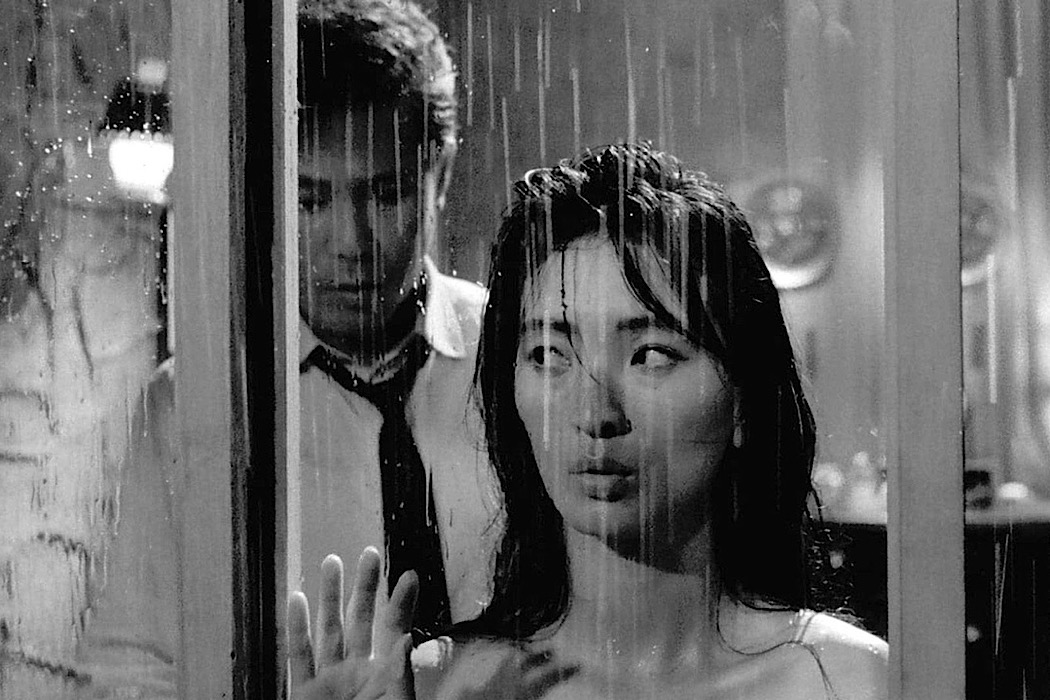
Lee Jutton has directed short films starring a killer toaster,…
With Parasite winning multiple Oscars, BTS topping the Billboard charts, and Squid Game smashing streaming records on Netflix, South Korean pop culture has had a major international breakthrough in recent years: one largely fueled by social media word of mouth, the works’ keen exploration of societal issues, and just mind-blowing amounts of talent. Yet to focus only on this New Korean Wave is to miss out on the incredible art the country has been producing for decades.
Indeed, long before Bong Joon-ho’s stunning satire of upstairs-downstairs relationships in Parasite, Kim Ki-young explored similar issues in his 1960 masterpiece The Housemaid, a film that has been cited by Bong and other South Korean filmmakers as the greatest film their country has ever produced. (It was later remade in 2010 with a cast featuring Lee Jung-jae—a future Emmy winner for Squid Game—and Youn Yuh-jung—a future Oscar winner for Minari.)
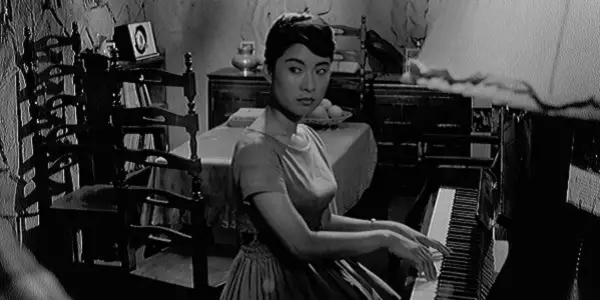
While The Housemaid might be the most renowned film to come out of South Korea in the immediate aftermath of the Korean War, it is only one of many fantastic films made during this remarkable period in the country’s history. Despite tight restrictions imposed by the military dictatorship that ruled South Korea at that time, filmmakers found clever, creative ways to comment on the pressing societal issues of the time, including the bitter taste that lingered in the mouths of many returning war veterans as they struggled to reacclimate to civilian life. Film at Lincoln Center and Subway Cinema are showcasing 24 of these films—many of which are rarely screened in the United States—in the upcoming retrospective Korean Cinema’s Golden Decade: The 1960s. If you’re intrigued by the idea of the series but overwhelmed by what is a veritable feast of films spread across a wide variety of genres, I’ve highlighted a few must-sees.
Goryeojang (1963)
Three years after The Housemaid (which is also screening in this series), Kim Ki-young released another masterful meditation on human relationships, this time focused on the horrors that ensue when people allow fear to govern their lives. Goryeojang chronicles the trials and tribulations of Guryong (Kim Jin-kyu), a man crippled due to an accident in childhood instigated by his ten bitter stepbrothers after they overhear the local shaman prophesize that Guryong will be the death of them all. Despite having no basis in reality, the seeds of fear and hatred planted by this prophecy are so deeply rooted that they have tragic consequences not just for Guryong, but for everyone else living in their famine-stricken village—a place where local tradition decrees that the elderly must be taken up into the mountains and left to die once they turn seventy.
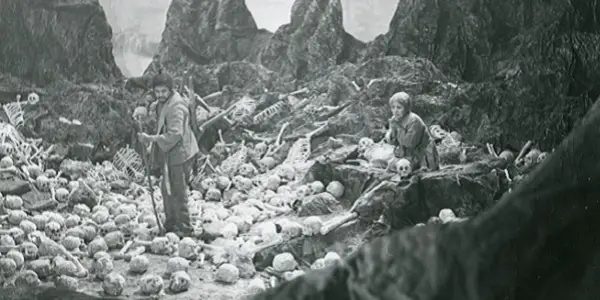
Goryeojang was restored by the Korean Film Archive in 2019; this version uses Kim’s original screenplay to provide onscreen depictions of the action that occurs in the third and sixth reels, which are unfortunately lost to the ages. Yet having to read key sections of action does not take away from the intense emotional impact that Goryeojang has on the viewer. Utterly uncompromising in its bleak depiction of a world ruled by superstition and selfishness, the film includes such horrifying events as a woman being brutally punished for taking revenge on her rapist, a child being sold for a sack of potatoes so she can be sacrificed to the gods, and a man being murdered in cold blood just so another can be framed for the crime.
In one of the film’s most heartrending sequences, Guryong is finally coerced into carrying his beloved mother up the mountain—an almost primeval place, littered with bones that crunch underfoot—after being told that doing so will finally bring rain to the famished village. Yet even as his mother goes willingly, she struggles when it comes time for Guryong to leave her alone at the top of the mountain, thus effectively sealing her fate. Her increasingly pathetic excuses to get Guryong to come back and spend just a few more moments with her are frustrating from an audience perspective—you wanted to go!—as well as deeply sympathetic—who wouldn’t suddenly be overwhelmed with fear at being left alone to die in such a barren place? When she finally shrieks her admission that she wants to keep living after all, it’s absolutely devastating.
Goryeojang is photographed in gorgeous, atmospheric black-and-white that gives the film an almost fantastical feel, as though the world in which these characters live and lie and die—a world centered around one magnificently gnarled tree that is practically its own character in the film—is somehow removed from our own. Yet their cruel behaviors are all too recognizable as those of real, imperfect humans acting under the influence of incredible hardship, doing whatever they think is necessary to survive. This unpleasant recognition is what makes Goryeojang such a powerful, necessary film even today—one that I would argue is even more of a masterpiece than The Housemaid.
Aimless Bullet (Obaltan, 1961)
Initially banned by the Korean government due to its critical depiction of post-war life, Aimless Bullet is now thought of as one of the greatest Korean films of all time—a reputation that is not undeserved. Directed by Yu Hyun-mok, it’s an incisive drama with noir flavor that follows the misfortunes of two brothers living in the slums of Seoul. The elder, Cheol-ho (Goryeojang’s Kim Jin-kyu), is an accountant struggling to make ends meet, plagued with a horrible toothache that he can’t afford to have treated. The younger, Yeong-ho (Choi Moo-ryong), is a war veteran who has been unable to find paying work in the two years since the war ended and instead spends most of his time drinking with other similarly disillusioned veterans. The rest of their family includes a mother suffering from debilitating PTSD, a sister named Myeong-suk (Seo Ae-ja) who has become a prostitute for American soldiers, and Cheol-ho’s pregnant wife and young children.
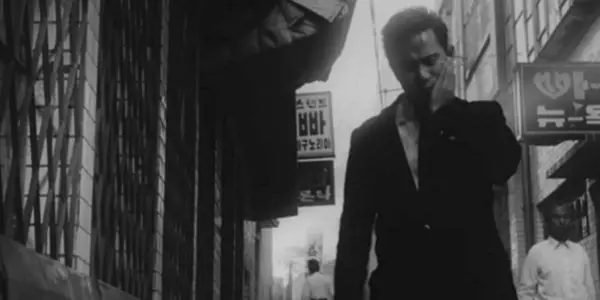
The war has left lasting scars on every character in the film: some physical, some mental, and in many instances, a terrible combination of the two. One of Yeong-ho’s fellow veterans, crippled from his war wounds, used to be Myeong-suk’s fiance but broke off their engagement due to his belief that his injuries now make him too much of a burden. Yeong-ho himself was shot in the side and treated at a military hospital where he met the lovely nurse Seol-hui (Mun Hye-ran); a chance encounter brings them back together after the war, but their burgeoning romance is practically guaranteed to end tragically. When an aspiring actress named Mi-ri (Kim Hye-jeong) offers to get the handsome Yeong-ho a job as a leading man in her next film, he is shocked and insulted to realize that it is because they want to exploit his wartime scars as part of his character; unwilling to part with what remains of his dignity, he turns the role down despite desperately needing the money, leading him down a dark path towards criminality.
There is very little in the way of hope or optimism in Aimless Bullet; as a portrait of an entire society ensconced in severe post-war depression, the film rivals Goryeojang for unrelenting unhappiness, which is no easy feat. (In addition, like Goryeojang, the film is beautifully photographed in black and white; Kim Hak-seong’s cinematography is rich in light and shadow, calling to mind the most visually evocative Hollywood noirs.) Yet while this all might sound unpleasant to the point of being impossible to watch, it is actually what makes Aimless Bullet such an important film—especially for American audiences, whose country shares in the legacy of the Korean War but is rarely forced to come face to face with the aftermath of the conflict.
Let’s Meet at Walkerhill (Wokeohileseo Mannapsida, 1966)
If you’re looking for the perfect palate cleanser after watching so many scathing societal dramas, Let’s Meet at Walkerhill is the film for you. A musical comedy that showcases the 1960s Seoul music scene to spectacular effect, the film follows two country bumpkins visiting the capital for the first time. The older of the two men (Seo Yeong-chun) is looking for his long-lost daughter after they were separated from each other during the Korean War; the younger (Twist Kim) is looking for his childhood sweetheart (Nam Jeon-im), a rising star on the nightclub circuit who believes that he died in a fishing accident many years ago.
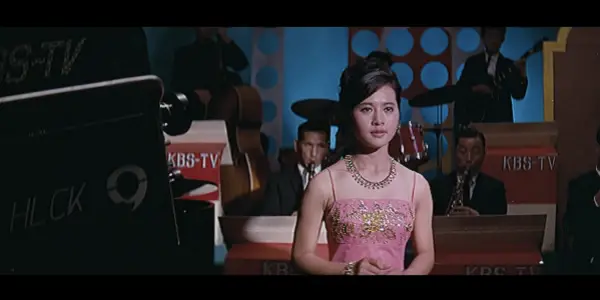
After the two men meet on the train to Seoul and decide to help each other on their respective quests, they find themselves struggling to navigate a city larger, louder, and more scandalous than they had ever dreamed; when they witness a woman doing a sexy dance in a club they are visiting, they start a fight to get her to stop that includes plates of pasta being thrown through the air. Some of the fish-out-of-water comedy is a bit too heavy on the slapstick, but these goofy moments are balanced out by so many great musical numbers highlighting some of South Korea’s top stars at the time, including the big-haired girl band Queen Bee covering The Supremes’ Come See About Me, Wicky Lee’s rollicking rendition of Gene Autry’s South of the Border (Down Mexico Way), and—most importantly—Nam Jeon-im’s emotional performances of the Korean-language songs Dark Farewell Letters and Only Tears Flow Down. When she sings, you fully buy into her character’s meteoric rise to the top.
Directed by Han Hyeong-mo, a filmmaker best known for directing “women’s pictures” in the 1950s, Let’s Meet at Walkerhill is a charming film that possesses the same joyful energy as the great Hollywood musicals of the era. The film was digitally mastered by the Korean Film Archive in 2013 using the original but incomplete 35mm camera negative, with a 16mm black and white print sourced from Hong Kong used to fill in the blanks. While this means that the film occasionally abruptly switches from candy-colored visual splendor to a colorless version of much lower quality, it doesn’t take anything away from how fun it is to watch; honestly, when one considers what they had to do in order to “complete” Goryeojang, I’m just glad they had another print to pull from at all. (And if all of these anecdotes haven’t yet convinced you of the continued importance of film preservation, I’m pretty sure nothing else will.)
The Great Monster Yonggary aka Yongary, Monster from the Deep (Daegoesu Yonggari, 1967)
As an unabashed kaiju aficionado, I was excited to learn that Film at Lincoln Center would be showcasing South Korea’s first monster movie….even if said movie has been described by Mystery Science Theater 3000 as “long on rampages and short on sensible behavior.” Really, when it comes to a kaiju film, that’s just an additional selling point! Screening in an English dubbed version on the only surviving 35mm print, The Great Monster Yonggary (released in the United States as Yongary, Monster from the Deep) is indeed illogical and outrageous, but if you’re like me, that makes it a must-see.
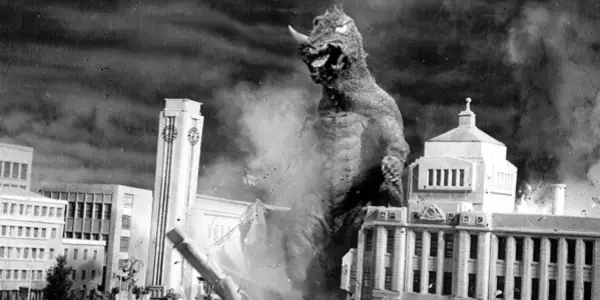
Like his Japanese forefather Godzilla, Yongary’s awakening is a side effect of the nuclear bomb—specifically, a nuclear test being carried out in the Middle East. When the test goes off, it triggers an earthquake…an earthquake with a mysteriously moving epicenter that appears to be heading straight for the heart of Korea. Eventually, the ground splits, revealing the giant horned monster inside, whom the authorities christen Yongary (portrayed inside a rubber suit by Cho Kyoung-min).
As the monster rampages across Korea—a delightful sequence of obvious miniatures being stomped on and set on fire in typical kaiju fashion—a young scientist named Il-woo (Oh Yeong-il) heads to the lab in an attempt to uncover Yongary’s weaknesses. The resourceful little brother of Il-woo’s girlfriend helps provide key evidence after he witnesses the monster drinking oil at a refinery; when the kid turns off the valve, an annoyed Yongary wreaks havoc, triggering a chemical reaction that causes him to itch and scratch. Could this chemical be the key to the monster’s defeat?
Directed by Kim Ki-duk, The Great Monster Yonggary was a co-production between South Korea and Japan; the latter nation’s more monster-experienced effects supervisors trained the Korean crew in special effects techniques. The plot is rife with holes, but when you’re watching the titular monster knock toy-sized buildings over, you won’t really care that none of it makes much sense. The dialogue is goofy to the point of being inadvertently hilarious, which is only emphasized by the cheesy performances of the English dubbers. (Perhaps in the original Korean with subtitles it would come off as less ridiculous.) It all culminates in what I found to be a surprisingly disturbing and graphic finale that may leave you with more sympathy for the monster than the humans who engineered his destruction (though I tend to always feel that way at the end of a kaiju movie, so maybe it’s just me). Still, unpleasant ending aside, The Great Monster Yonggary has pretty much everything else you could want out of a midcentury monster movie.
Korean Cinema’s Golden Decade: The 1960s takes place at Film at Lincoln Center in New York from September 1-17, 2023. The series is co-presented by Subway Cinema in collaboration with the Korean Cultural Center New York and the Korean Film Archive.
Does content like this matter to you?
Become a Member and support film journalism. Unlock access to all of Film Inquiry`s great articles. Join a community of like-minded readers who are passionate about cinema - get access to our private members Network, give back to independent filmmakers, and more.
Lee Jutton has directed short films starring a killer toaster, a killer Christmas tree, and a not-killer leopard. Her writing has appeared in publications such as Film School Rejects, Bitch: A Feminist Response to Pop Culture, Bitch Flicks, TV Fanatic, and Just Press Play. When not watching, making, or writing about films, she can usually be found on Twitter obsessing over soccer, BTS, and her cat.













